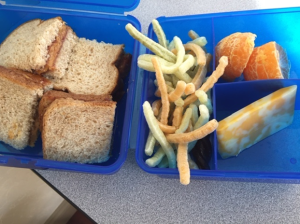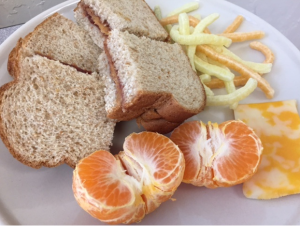Blog
We know that children’s eating habits and their ability to make independent choices around food is an important conversation. As parents you worry. We are asked every day if a child has eaten their lunch and how to make them do that.
Our classrooms offer the best opportunity to teach the children about nutrition, manners, and care of their environments. We are paying close attention to enjoying the lunch time meal and snack time with the most grace and courtesy practice we can provide. Our lunch time provides them opportunities to practice independence, independent eating, and caring for the classroom.
The children set the tables with real linen placemats and napkins. They lay out their own lunches onto plates, eat with silverware, and drink from water glasses. They clean up their lunches when they are done
Here are some areas we focus on:
Independence: Every element of an ideal Montessori lunch program is designed to support the children’s developing self-reliance. Simply put, children eat several times a day. Preparing, serving and cleaning up lunch reinforce the practical, real-world skills Montessori programs are designed to develop.
Continuity: A lunch served and cleared by the children provides seamless continuity with classroom Practical Life activities, whereas a lunch served and cleared by adults is simply out of synch. Mixed messages are confusing (even for adults!). Continuity at the lunch table supports and enhances the goals of the entire program.
Grace & Courtesy: Hearing a young child say to a friend, “Would you like to join me?” as he politely motions to the snack table is a delight that never grows old. After lunch, children carefully tuck in their chairs, a practice that will stay with them for life. There is simply no better opportunity for children to hear and say polite words and phrases than the lunch and snack table. “May I pour you a glass of water?” “Yes, please.” “Thank you.” “You’re welcome.”
Socialization: When the children dine together in a relaxed setting, they have an opportunity to engage in conversations with each other AND they have a ready-made topic of conversation: food! Teachers at the table have an opportunity to model asking appropriate questions (“I’ve never seen fruit like that. What is it called?”) and giving appropriate responses (“It’s called cherimoya. Let’s ask your mom if she can find one at the grocery for you.”)
Observation: Happy children enjoying a Montessori-style lunch offer teachers a superb chance to evaluate how children are extending their Practical Life skills to a real-world setting. Teachers can’t follow children home to observe! Observation allows teachers to identify a child’s individual needs – and provide for them! Is she having trouble pouring? She may need more access to pouring activities or an individual presentation. Does he break the crackers whenever he tries to spread them with peanut butter? He may need more opportunities to hone his fine motor skills.
Teachable Moments: Conversations about food are chock full of language opportunities! Some ideas include naming fruits and vegetables – children love saying words like jicama, edamame, pomegranate, and kiwi. You might also talk about the shapes of the containers to reinforce what the children are learning in Sensorial. Hard-boiled eggs are ovoid. Blueberries are spheres. Many containers are cylinders.

Clean-up: Ideally lunch clean-up is treated as a Practical Life activity; supplies are available for the children to use. They crumb their own placemats and wipe their own tables. They sweep the floors and if necessary use the mop to pick up water spills. They tuck in chairs, a habit which will serve them for life.
We suggest giving your children an appropriate portion of food for their age and appetite. A small selection is best; a protein, a fruit, and a bread. They do not need water as filtered water is available to them all day in small glasses. If you prefer they drink milk with lunch, please provide a pourable thermos and a cold pack.
Because the children are growing in their independence please send food that they can easily eat with a spoon or fork, or by hand. The children take their food out of the containers and packaging and lay it on a plate, so the containers should be easy to open. Please keep in mind that the children do need to wait to have their food heated. If you need help in choosing the right container, or food, please ask us!

In our effort to create less transitions for the children, they will sleep in their own classrooms. This allows extra time for lunch since there is not a need to clean up so that the nappers move into the next room. As the children are cleaning up from lunch the youngest and the sleeping children can help put their nap cots down off into a corner of the class. The older children can gather for a story and everyone can listen. The room will be quiet and lights dimmed.
The older children and any child who cannot sleep can get up and help to clean the classroom, read a book, do work quietly. There will be three teachers in the classroom with the children so there will be ample time for books, art, and gardening.